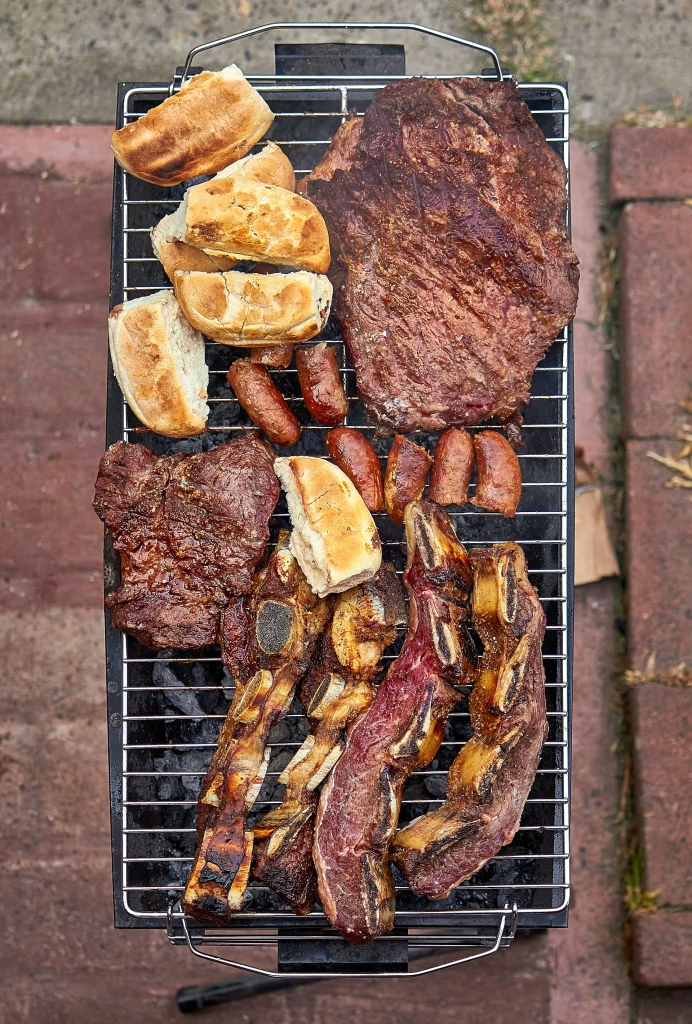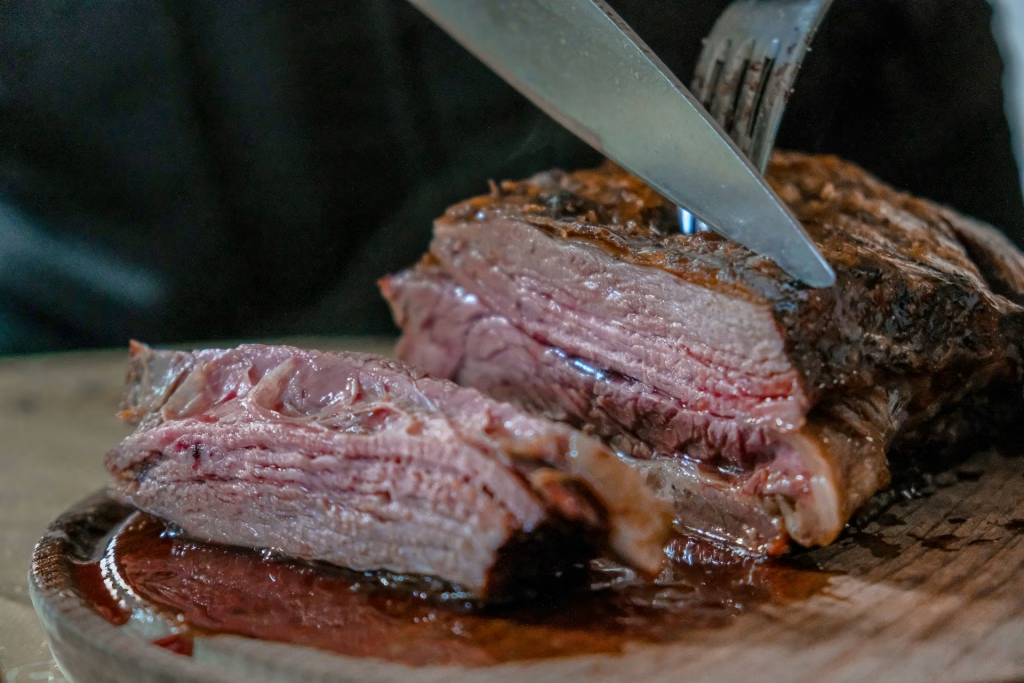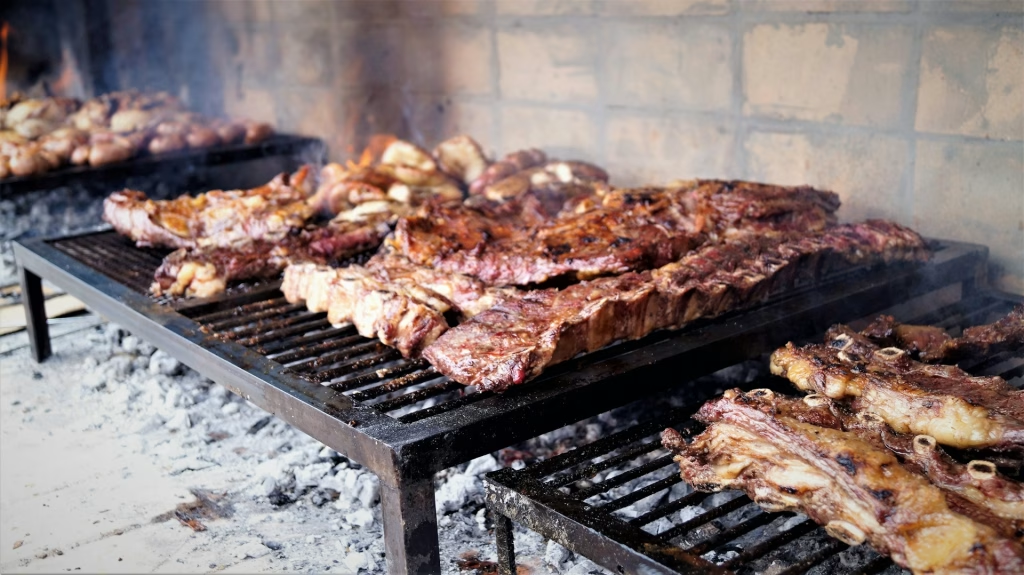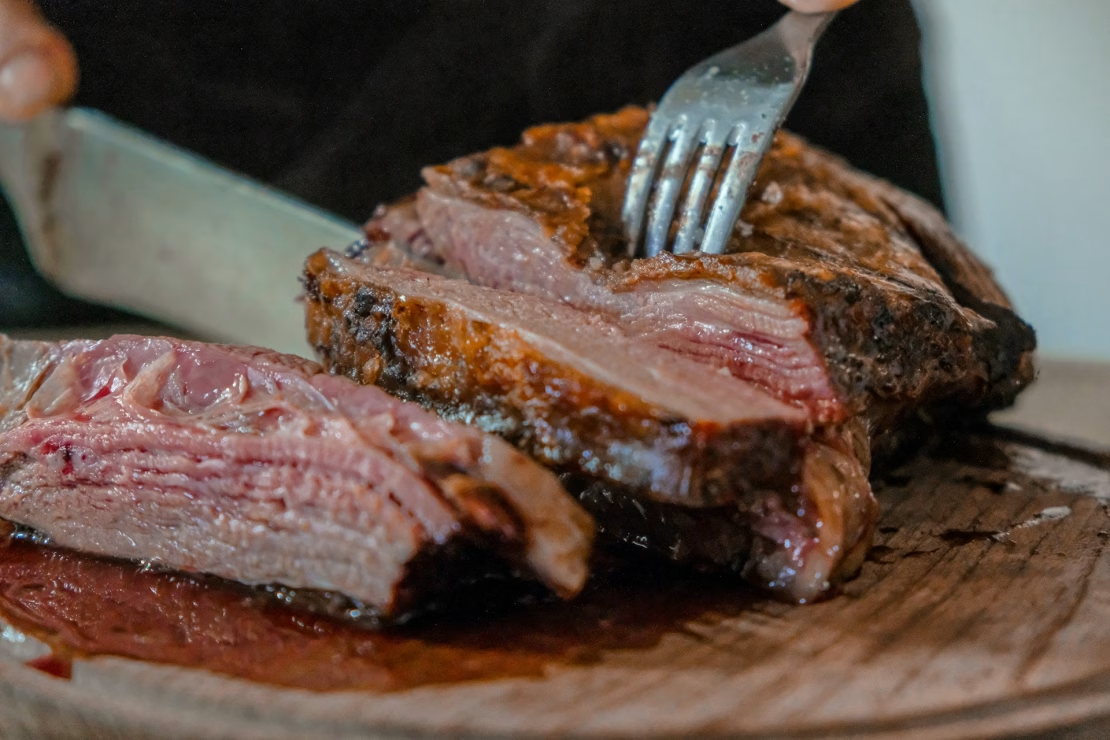Argentinian Grilled Steak (Asado) is more than just a method of cooking meat—it’s a cherished tradition, a social gathering, and a culinary expression of Argentina’s cultural pride.
Celebrated across backyards, ranches, and patios, the asado brings friends and family together around open flames and sizzling cuts of beef, cooked slowly to perfection. With its roots deeply embedded in gaucho (cowboy) heritage, the Argentinian Asado is all about simplicity, quality ingredients, and the ritual of fire.
In this comprehensive guide, you’ll learn how to master the art of the asado—from choosing the right cuts and building your fire, to mastering timing and technique.
Table of Contents
Ingredients
For the Steak (Traditional Asado):
- 2 lbs beef short ribs (costillas)
- 2 lbs flank steak (vacio)
- 1 lb chorizo sausages
- 1.5 lbs blood sausage (morcilla) (optional)
- Coarse sea salt (as needed)
For the Chimichurri Sauce (Traditional Accompaniment):
- 1 cup flat-leaf parsley, finely chopped
- 5 cloves garlic, minced
- 1 tablespoon dried oregano
- 1 teaspoon crushed red pepper flakes
- ½ cup red wine vinegar
- ¾ cup olive oil
- Salt and black pepper to taste
For the Fire:
- Hardwood charcoal (or quebracho wood if available)
- Firestarter (paper, dry twigs)
- Grill or parrilla (Argentinian-style grill)
Serves
6–8 people
Step-by-Step Instructions
1. Preparing the Fire
- Traditional Method: Build your fire using hardwood charcoal or, for the most authentic flavor, quebracho wood. Allow the coals to burn down until they’re covered with a light gray ash. This usually takes about 30–45 minutes.
- Create a two-zone fire: one side with direct high heat, and the other with indirect heat for slower cooking.
2. Season the Meat
- Do not marinate the meat. Argentinian tradition emphasizes natural beef flavor. Instead, generously salt each side with coarse sea salt just before placing on the grill.
3. Grilling the Meat
- Start with sausages and morcilla: These cook quicker. Place over medium heat and turn occasionally until golden and firm (15–20 minutes).
- Costillas (short ribs): Place bone-side down on indirect heat. Grill slowly for 1.5 to 2 hours. Flip only once during cooking.
- Vacio (flank steak): Grill on medium heat for 20–25 minutes per side, depending on thickness.
4. Make the Chimichurri
- While the meat is grilling, combine all chimichurri ingredients in a bowl. Let sit at room temperature to meld flavors.
5. Rest and Serve
- Remove meat from the grill and rest for 5–10 minutes before slicing. Serve with warm bread and generous drizzles of chimichurri.
Serving Suggestions
- Serve meats on a large wooden platter or board.
- Accompany with grilled vegetables (like red peppers, onions, eggplants).
- Include fresh bread, provoleta (grilled provolone cheese), and salads such as Ensalada Rusa (Russian potato salad).
- Red wine, especially Malbec, is the classic beverage pairing.

Tips for Perfect Asado
- Low and Slow: Asado is about slow grilling, not high-temperature searing.
- Minimal Flipping: Turn meat once only to maintain juices and crust.
- Control the Fire: Mastering heat zones is crucial—keep coals replenished and move meat accordingly.
- Quality Over Quantity: Use high-quality, grass-fed beef if possible.
- Resting Is Key: Let meat rest after grilling to allow juices to redistribute.

Healthier Alternatives
- Lean Cuts: Swap short ribs for leaner cuts like bife de lomo (tenderloin).
- Turkey or Chicken: Use boneless skinless chicken thighs or turkey steaks.
- Vegetarian Options: Grill portobello mushrooms, eggplants, or plant-based sausages with chimichurri.
- Light Chimichurri: Use less oil or substitute part of the oil with water or broth.
Creative Variations
- Smoky Twist: Add soaked wood chips for a smoky flavor.
- Spiced Chimichurri: Mix in smoked paprika or cumin for a bold twist.
- Stuffed Provoleta: Top grilled provolone with herbs, tomato slices, and olives.
- Asado Sandwich: Serve leftover steak in crusty bread with chimichurri and grilled onions.
Common Mistakes to Avoid
- Using a Gas Grill: It misses the flavor from real firewood or charcoal.
- Over-Marinating: Traditional asado doesn’t involve marinades—salt only!
- Cooking Too Fast: Rushing ruins the tenderness.
- Not Resting Meat: Skipping the resting phase dries out the steak.
- Using Table Salt: Coarse salt allows better control and crust development.
- Flipping Frequently: This prevents proper caramelization.
- Incorrect Fire Setup: Always establish heat zones.
- Overcrowding the Grill: Leave space for airflow and even cooking.
- Neglecting Chimichurri: It’s a vital flavor element.
- Serving Cold Meat: Plan to serve fresh off the grill, warm and juicy.
History of Argentinian Grilled Steak (Asado)
The origins of the Argentinian Asado can be traced back to the 16th and 17th centuries with the arrival of Spanish colonists and their cattle to the Pampas. The open plains of Argentina, abundant with fertile grazing lands, quickly became home to massive herds of cattle. The gauchos, or cowboys, living on these lands, developed a method of grilling beef over open flames using nothing but wood, salt, and primal intuition. This became the earliest form of the asado.

Asado evolved not just as a cooking method, but as a social and cultural experience. By the 19th century, it had become embedded in Argentine national identity. Families would gather every weekend for an asado in backyards or fields. Over time, regional styles emerged, and the act of grilling came to symbolize hospitality, togetherness, and respect for tradition. The inclusion of sausages, morcilla, provoleta, and side salads added to the experience, but the heart of it remains in the ritualistic cooking of beef over embers.
In modern Argentina, asado is more than just a meal—it’s a lifestyle. Whether celebrated in rural estancias or urban patios, it remains a sacred tradition that connects people with their heritage, landscape, and community. Internationally, it has gained popularity due to the rich, smoky flavor and communal atmosphere it fosters, becoming a sought-after experience for tourists and food lovers alike.
FAQs about Argentinian Grilled Steak (Asado)
1. What is the best cut of meat for an Argentinian Asado?
Traditional cuts include short ribs (costillas), flank steak (vacio), and chorizo sausages.
2. Is marinade used in authentic asado?
No. Authentic asado only uses coarse salt to highlight the natural flavor of the beef.
3. What’s the difference between a parrilla and a regular grill?
A parrilla is a traditional Argentinian grill with a V-shaped grate and adjustable height, ideal for slow cooking over wood embers.
4. How long does it take to prepare an asado?
It typically takes 1–2 hours to cook the meats properly, plus 30–45 minutes to get the fire ready.
5. Can I make asado indoors?
While possible with a cast-iron grill pan, it won’t capture the wood-fired flavor of a true asado.
6. What is chimichurri and how is it used?
Chimichurri is a garlicky parsley sauce served alongside grilled meats. It’s fresh, tangy, and herbaceous.
7. Can vegetarians enjoy an asado?
Yes—grilled vegetables, provoleta, and plant-based sausages are excellent vegetarian additions.
8. Why is asado considered a cultural tradition?
Asado is deeply tied to Argentina’s gaucho history and serves as a social ritual uniting families and communities.
9. What drinks pair best with asado?
Full-bodied red wines like Malbec are the ideal pairing, though cold beer is also popular.
10. How do I know when the meat is ready?
Use visual cues—crispy exterior, juicy interior—and a meat thermometer for accuracy: 130–135°F for medium rare.
Argentinian Grilled Steak (Asado) is not just a dish—it’s an experience steeped in tradition, patience, and pride. Whether you’re hosting a backyard gathering or simply craving a taste of South American soul, the asado offers more than just a meal. It offers connection—to the land, to history, and to one another. With its flavorful meats, simple techniques, and communal spirit, mastering the asado is mastering a piece of Argentinian heart and heritage. Fire up the grill, gather your friends, and let the smoky aroma of an authentic asado transport you to the Pampas of Argentina.


